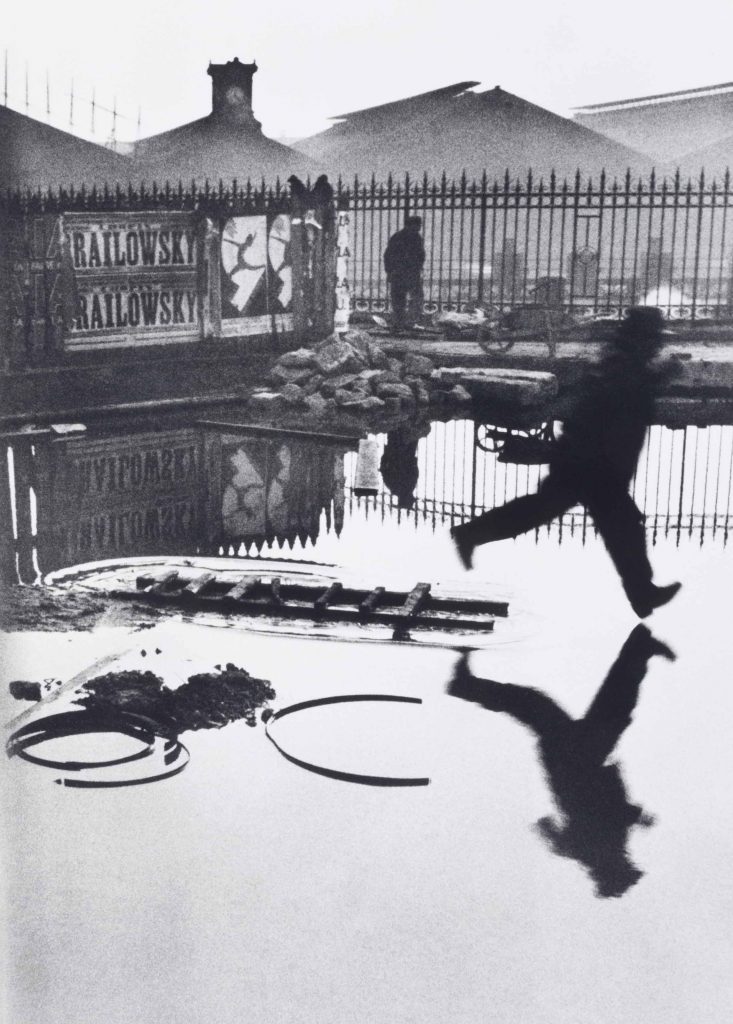Exercise 5.3: Looking at photography
If photography is an event then looking at photography should also be an event. Look again at Henri Cartier-Bresson’s photograph Behind the Gare Saint-Lazare in Part Three. Is there a single element in the image that you could say is the pivotal ‘point’ to which the eye returns again and again? What information does this ‘point’ contain? Remember that a point is not a shape. It may be a place, or even a ‘discontinuity’ – a gap. The most important thing though is not to try to guess the ‘right answer’ but to make a creative response, to articulate your ‘personal voice’.
Include a short response to Behind the Gare Saint-Lazare in your learning log. You can be as imaginative as you like. In order to contextualise your discussion, you might want to include one or two of your own shots, and you may wish to refer to Rinko Kawauchi’s photograph mentioned above or the Theatres series by Hiroshi Sugimoto discussed in Part Three. Write about 300 words.

When I started this course one of my goals was to understand what made a great, a good photo from a not so good, or at least have a framework that allowed me to read an image, a picture, rather than just reacting to it. Terry Barrett’s essay ‘Photographs and Context’ has helped me make sense of, and appreciate images by considering different types of context. In the case of ‘Behind the Gare Saint-Lazare’ I have always accepted that this was a great photograph simply because it hangs in galleries, is referenced in countless articles and because Cartier Bresson took it. This is what Barrett refers to as external context and until recently was my main source of influence about how I reacted to this image.
It says a lot about this photograph, that until I studied this course, I never consciously noticed a lot of the elements in it (the internal context). My eye was always drawn to the gap between legs, the point where the heel of the foot is about to touch the water, and the reflection. I never noticed the railings and the man and their refection, the ‘Railoswky’ letterings, the buildings in the background, the dancers in the posters-none of it-just that frozen moment of the foot, imagining the splash to follow as it connected with the water- its that moment of anticipation of what happened next.

Hiroshi Sugimoto took long exposure photos-he opened his shutter as a film began and closed it as it concluded- “Different movies give different brightnesses. If it’s an optimistic story, I usually end up with a bright screen; if it’s a sad story, it’s a dark screen. Occult movie? Very dark.”
As Barret says in his essay “Because photographs are also segments of time excised from a temporal flow, one is wont to reconstruct, at least imaginatively, the moments before and after the one that is shown”(Barratt, 1997: 116). For me, that is the pivotal point in the photo. Like Hiroshi Sugimoto’s Theatres series there is a durational element at play-although Sugimotos images were a much longer duration (exposure wise) and left us with a white screen in the theatre, we still know and anticipate that a movie was shown, just as we know that Cartier-Bresson man’s foot splashed into the water. This is the beauty of photography, freezing a moment (or moments in Suigimoto’s case) and contemplating what went before and what came after.
I also find it interesting that Cartier-Bresson said there was a bit of luck about the shot-he slipped the camera between two planks and didn’t see the man running and this is often ignored from a context perspective in articles and analysis. If photography is simple then this is a great example of that-sticking a camera between planks and pressing the shutter. It doesn’t take anything away from the photograph but does tell us that we need to be open to luck and take it when the opportunity presents its self.
There was also an element of luck about the image below-I was on a day trip to Dublin and it has rained heavily for most of the day. When it eventually stopped I was taking my camera out of my bag at the roadside when I happened to look up and see the man walking in front of the puddle, without looking through the viewfinder I simply raised the camera and pressed the shutter, freezing that moment in both the street and the puddle. Did the man walk around the puddle or into it? Five seconds later the man had passed by and an hour later the puddle and the world within it was gone.

When looking at the photo for this exercise I found Barrett’s different types of context very useful. I was conscious that much has been written about the shot (and in some respects over analysed), of Cartier-Bresson’s reputation, but my eye kept coming back to that point where the man’s foot is about to connect with the water-that frozen point laden with the expectation, where my imagination attempts to work out what’s about to follow. The rest of the photo is window dressing.

